September is a busy month for Tastings, so I apologise that this article is appearing, unusually, almost a week after the event. I’m covering five importers here: Maltby & Greek, Modal Wines, The Knotted Vine, Basket Press Wines and Red Squirrel Wine. I simply didn’t have time to get to Nekter Wines and Roland Wines. I did taste rather a lot of wine, and spent a long time, with Uncharted Wines, and perusing at my notes it looks as if I tasted rather more wines with Swig than I thought I had. But I’m off to their joint tasting in London tomorrow, so they will get a piece to themselves, a blend of the two events.
In his welcome to Out the Box 2018 David Knott (of The Knotted Vine) stated that he has one goal: “to bring together the most exciting group of young importers focused on importing minimal intervention wines in the UK…”. There is no doubt in my mind that he has succeeded. Out the Box is, for me, one of the most exciting Tastings now established on the London circuit. It contrasts with other similar Tastings in that pretty much every wine has some sort of individual personality, something to say for itself. The wines are not “safe” and none are boring, and I’m sure not all of the wines will appeal to all palates, but a wine that has little to say for itself here is a rarity.
In exploring the importers here you will doubtless come across wines you’d never think of trying. The advantage of attending is that you can explore some pretty obscure wine regions, and try some producers from more well known regions who you may never have come across. But in purchasing these wines from such a group of young importers you are also supporting the future of the wine trade, and supporting those who, in pushing the boundaries, are creating the mainstream of the future.
There have been people predicting wine trends for as long as there has been wine writing. I think that Out the Box is always one of the places to spot future trends, or certainly to have them confirmed. It’s not hard to see that the wines of Central Europe and The Balkans are making great strides, and at the very top of the pile for excitement I’d place Moravia in the Czech Republic, in whose wines Basket Press specialises. I’d also suggest that the time for Greek Wine to finally break through might finally come in 2019. We shall see.
South Africa, of course, continues to grow beyond expectations, finally, and Swig is right behind this groundswell, as also is Red Squirrel. It’s pretty clear that wine on tap is a big thing, largely the result of the catalyst effect of Uncharted Wines, but that will have to wait for my next article.
MALTBY & GREEK
Maltby & Greek has been going for about six years now, based originally in the wonderful market in Bermondsey’s Maltby Street (now in Arch 17 of the Apollo Business Park). They supply a wide range of Greek produce, including a good portfolio of Greek wines, of which just shy of forty were on show last week.
Douloufakis Winery Sparkling Vidiano 2017, Dafnes, Crete – Three sparklers were on show to kick things off, all good, and all of which I’ve tried before. My favourite, though I like this grape variety anyway, was this Cretan Vidiano. Very frothy, but underneath the intense mousse and bead there is bags of fruit and citrus flavour. Just a little complexity balances the freshness, but this is at its core a delicious thirst quencher.
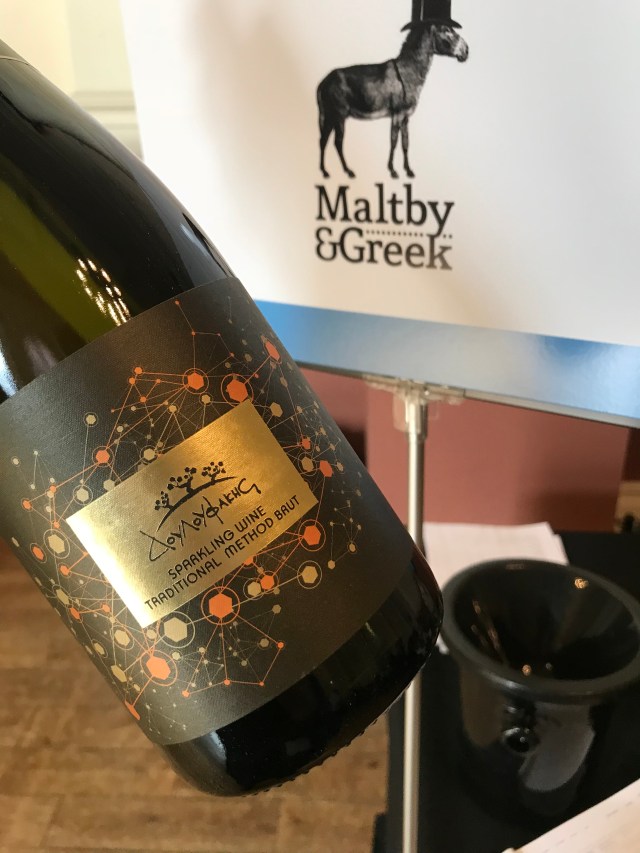
Other M&G highlights included reds from the Peloponnese and Tinos. Rouvalis Winery “Tsigello” 2017 is made from one of Greece’s finest red varieties, Mavrodaphne, in Aigion, in the far north of the Peloponnese, not far from that grape’s natural home of Patras. Tsigello is actually a top quality Mavrodaphne clone. It’s a dark wine, as Mavrodaphne habitually is, with 13% alcohol. It combines freshness, possibly a result of the vines being at 650 metres altitude, with lovely sweet fruit. It finishes with a touch of tannin and texture. Ageing is in a mix of French oak and amphora. Extremely good value at just under £10 to the trade, I thought.
Vapistis Winery “Vapistis Red” 2016 is an altogether more serious wine. The varietal mix is listed as Mavrothiriko (70%) and Mavrotragano (30%). It comes from Tinos, an island in the Cyclades, and it sees a 12-day maceration followed by six months on lees in stainless steel. Then it is allowed four months in bottle before release. The wine has a very moderate 11.5% abv, and I caught a bit of reduction on the nose. But this is really promising. The fruit in this ruby wine is really intense. Beneath the fruit is a spiciness, certainly nutmeg (I adore nutmeg), and the wine has a sweet and sour richness to the finish.
My favourite wine from M&G at this tasting comes from one of my two favourite Greek producers, Domaine Kalathas, also from Tinos (my other favourite is, for the record, Ktima Ligas). Domaine Kalathas “Sainte Obéissance” 2016 is an old vine Aspro Potamisi-Rozaki blend (indeed!). The Aspro Potamisi (80% of the final blend) is initially vinified in stainless steel, and then it sees “a refermentation and reduction of 10g of sugars the following spring”. Then, after malolactic, 20% of the same vintage’s Rozaki is blended in. It might sound complicated, but the intense nectarine bouquet and really fine fruit are all you need to fall in love with this. There’s a touch of salinity as well. Try it with a saffron monkfish stew with fennel and couscous. One of my wines of the day. #tinoseveryday!

MODAL WINES
Nic Rizzi has built up a wonderful portfolio of “small-batch” (as he calls them) wines in a short time. None is more wonderful than the guys I headed here to taste, though I do somewhat shoot myself in the foot for plugging them – Joiseph. Luka Zeichmann only founded Joiseph a couple of vintages ago, at Jois near the top end of Austria’s Neusiedlersee in Burgenland. A young man, still well in his twenties, Luka is potentially a future star of the region.

Nic Rizzi
Joiseph Mischkultur 2017 blends Grüner Veltliner, Traminer and Welschriesling and other varieties in tiny quantity. There is a little skin contact for some varieties, and it sees élevage in old oak. It’s a slightly cloudy wine but massively flavoursome.
Rosatant 2017 is a pure Blaufränkisch rosé. The fruit gets a six hour maceration for colour and then gets popped into just two 500 litre barrels. It’s a pale wine, very good fruit, lively, but with a lick of spice to add interest.
Roter Faden 2017 is Luka’s current red blend (I should say that he still only has around three hectares of vines) in 2017. Zweigelt (50%), Pinot Noir (30%) and Blaufränkisch (20%) gives a palish but bright wine, where the Zweigelt is given a ten day maceration (the rest just three days). The result is a fruity wine with a sour cherry finish.
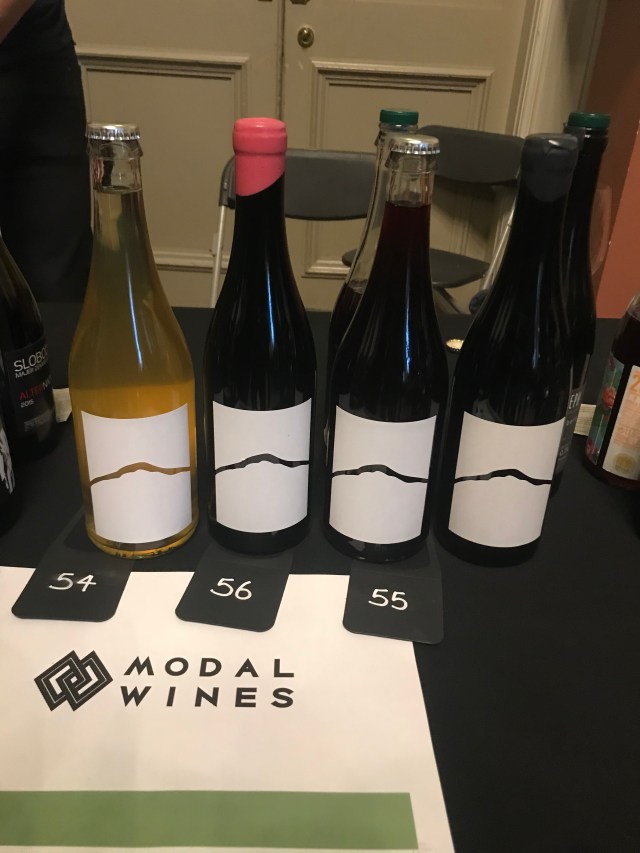
Very good indeed as all these three are (all bottles I’d go out of my way to buy), another of my wines of the day was Luka’s Tannenberg from the badly frost hit 2016 vintage. This 100% Zweigelt comes from the vineyard (sort of) depicted on all the Joiseph front labels (photo above). It’s Luka’s best parcel, on schist. Fifteen months in 225 litre oak after the grapes have undergone a light infusion on the skins, following destemming, gives a wine with a lifted, slatey, nose and bags of concentrated red fruits. There’s acidity to match. It’s a genuine terroir wine, but reflecting a cold vintage in its tight focus. Stunning!
Sadly only 300 bottles were made. Please save me one, Nic, or failing that, just save me anything from Joiseph.

Modal Wines is not just Joiseph. Slobodne, from Hlohovec in Slovakia, is another of my favourie Modal producers. I recently drank their gorgeous Deviner (see here, in my review of Modal Wines at Plateau Brighton back in May). That wine was on show at Out the Box, but I’m going to mention two others here.
Jantara 2017 is a blend of 70% Pinot Gris with 30% Grüner Veltliner, where the former sees five weeks on skins, the latter variety two weeks. A mineral core is surrounded by savoury fruit. Rebela Rosa 2017 is a pinkish-orange colour, containing equal amounts of Blaufränkisch and Cabernet Sauvignon. It gets directly pressed and then sees eight months in vat. This is a fairly soft wine with a mineral grip and texture, and a 13% alcohol content which you don’t really register.
Finally from Modal, a wine from a producer I’d not tried before, Lectores Vini “Pomagrana” 2017. This comes from Conca de Barbera in Spain, and although there is 10% Grenache in here, the rest is made up from Trepat. Now Trepat is quite common in Conca de Barbera and neighbouring Costers del Segre, and there are still around 1,500 hectares planted. This is because it is used largely to make rosado wines. But one or two forward-thinking producers are starting to make promising reds.
Pomagrana sees a two-week maceration to gain more colour and some texture. The grapes are then pressed and returned to stainless steel. There’s no carbonic here. The fruit is a frankly delicious redcurrant, pomegranate and cranberry mix, with added spice. I’ve tried a few Trepat reds and I think this crunchy red fruit thing it has going for it will make it popular with anyone looking for this kind of style. A great wine for bar drinking.
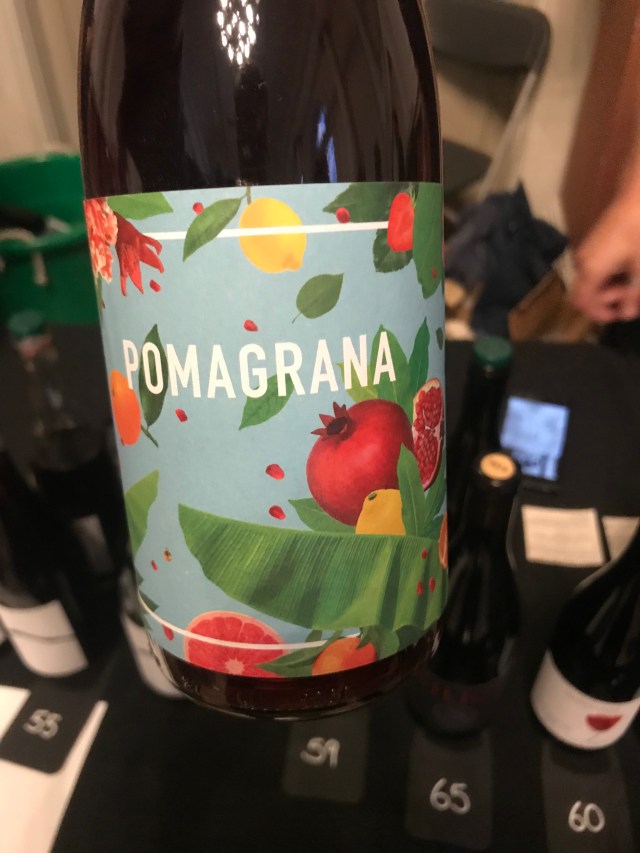
THE KNOTTED VINE
David Knott is passionate about his growers, but he’s also one of the most astute of the small importers. He’s got a number of really good European producers on his books, but perhaps he truly excels in picking out a small number of Australians who, when you try them, you wonder why no one has got there first.
It’s a close call but I am picking out here the producer I think just about tops the list. It is also a producer who does seem to be starting to get recognition this year (I keep seeing bottles in restaurants, if that’s anything to go by). Koerner is a Clare Valley producer run by brothers Damon and Jonathan Koerner. But their wines don’t necessarily fit the standard mould of the region. This is largely because I think they reject the idea that especially Clare white wine needs to age for a decade or so.
Koerner Watervale Riesling 2017 is therefore very different to the “Grosset” ideal. The skins macerate over night and then the juice is pressed, half to amphora and half to stainless steel. This is much richer and softer than anything you’ll have tried from the region, a wine full of new flavours and textures. Try it.
They produce a couple of Vermentino wines, differentiated by cuvée names which don’t necessarily reflect their styles. Pigato 2017 is another nicely rounded out wine, always slightly cloudy, richer and more textural than much of the Ligurian version, after which it is named, will be. It has three weeks fermenting on skins. Rolle 2017 is named after the Provençal version of Vermentino, which I usually find rounder and softer than the Ligurian. Here, we see a cuvée that is made by macerating the skins overnight and then it goes into big slavonian oak foudres. It has a certain Riesling quality and as much as I’ve enjoyed bottles of the Pigato, this is impressive.
La Corse 2017 is a mixture of Sangiovese, Malbec, Grenache and Sciaccarello, which sees two months in new oak and amphora. Quite inspired, this is a lifted, pale red with a fresh and slightly dusty nose. Picked early, it exudes freshness, and I think the Sangiovese fruit shines here.
The Clare 2017 nods towards Bordeaux, blending Cabernet Sauvignon, Petit Verdot, Malbec and Cabernet Franc, with the (increasingly common) twist that it has ten months in amphora. There are intense fresh acids and dusty tannins again, a powerful wine in many ways, yet still light in others.
Nielluccio 2016 is a Clare Valley 100% Sangiovese this time. The cuvée name is inspired by Corsica, of course, and it does have a rugged quality. “Light and bright”, say my notes. Just chilled, this was delicious, showing good fruit but a bite on the finish.
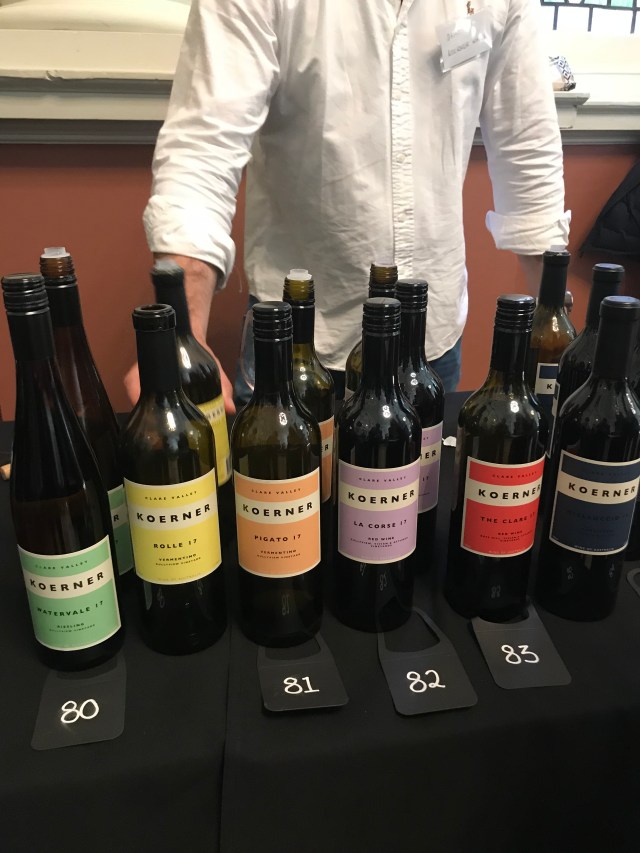
I wanted to try the wines of Noelia Ricci, having heard good things about them. The original Tenuta Pandolfa was created by Noelia’s father, Giuseppe Ricci, who revived winemaking after the destruction of WW2. After he died in 1980, Noelia took over with a strong vision to make exciting wines. This Emilia Romagna estate is now in the hands of her granddaughter, Paola Piscopo.
Bro Bianco Forli 2017 is made from the humble Trebbiano grape. It’s clean, fresh and simple, a wine perhaps for simple pasta dishes such as ravioli stuffed with pumpkin and herbs. An unloved variety, but a nice wine.
Godenza 2015 is, despite some bottle age, still remarkably fruity. The fruit is super-concentrated, but it isn’t heavy, nor is it complex. It’s a very nice, slightly different, interpretation of Sangiovese. Both wines show a simple purity that is quite beguiling.
Also from Italy, but quite different, is Albino Rocca. This is a name you might know. They used to be imported by a bigger name agent, but they were dropped. Under biodynamic conversion, and with a real focus on quality at every level, the rejuvenated Albino Rocca has been snapped up by David Knott.
Langhe Chardonnay “da Bertu” 2017 was very good, in a fresh and lighter style with a medium body (for Chardonnay). Barbaresco 2015 is an ageable wine, palish (as I like my Nebbiolo), with a clearly defined varietal bouquet showing a nice, haunting, florality. It has a 2015’s body, with a touch of muscle and quite youthful tannins still.
Barbaresco Vigneto Ronchi 2009 is a single vineyard lying east of Pajé, on the border with Nieve. The vines are old here, between fifty and seventy years, on chalky clay. This is quite old school, bright in colour, concentrated and still young. This estate is one that perhaps would have been listed among the modernists in the 1980s, but the oak is being dialed back these days and, as biodynamic conversion illustrates, a far more thoughtful approach to viticulture is also being brought in. This 2009 could be drunk now, but it does have the potential to get even better. An estate on the way back to greatness?
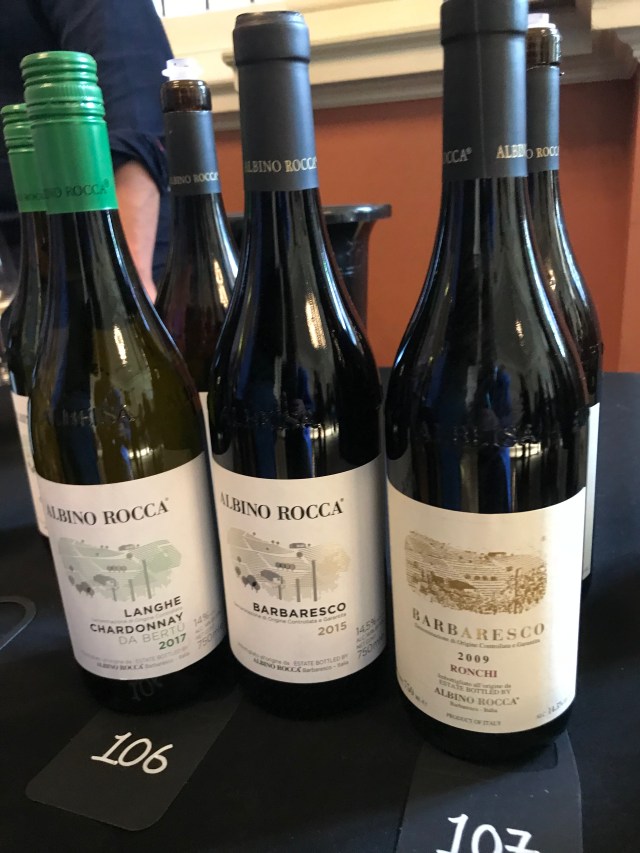
David Knott delves into the Iberian Peninsula a fair bit, and I was able to chat with one of his producers on the stand, Gorka Mauleon of El Mozo. This is a producer from Lanciego, in the Rioja Alavesa sub-region, the smallest of the three, just north of Logrono. They own some lovely old vines which the family planted in the 1930s. There are around nine hectares in total, spread over 18 plots, and Gorka calls the wines produced “microwines”. The project Gorka has embarked on since taking over is to make wholly natural wines with no added sulphur, and where possible using carbonic maceration to make vibrantly fruity wines.
Herrigoia 2017 contains both red and white varieties, very common at El Mozo, and traditional in Rioja Alavesa. In this case it is Tempranillo with Viura and Malvasia. It’s a fruity red in the aperitif style, very easy to drink.
El Cosmonauta is a wine you may have seen, the brightly coloured label (it comes in a number of different cuvées) depicting a cosmonaut spacewalking. This pale red is in the “clairette” style, and is based on the kind of wine Gorka’s grandfather, Teodoro, made. The grapes (Tempranillo, Garnacha, Viura, Malvasia and Torrontes) come from over 600 metres up Monte Viñaspre, just north of Lanciega. Pure glouglou, or whatever the Spanish/Basque equivalent is.
BASKET PRESS WINES
Czech Moravia has, for me, been my most exciting wine discovery of the past twelve or so months. I had no idea that such exciting quality wine was being made by artisan producers not all that far north of Vienna, over the border in the Czech Republic. And it’s not as if these wines have just started being made. The natural wine movement in Moravia has been going a good few years.
Jiri and Zainab of Basket Press Wines are not the only people importing from Moravia, but they are true specialists with deep, on the ground, knowledge. I first met them at Plateau (again) in Brighton, for a Tasting back in February, which you can read about here. These wines are seriously exciting and worth getting to know.
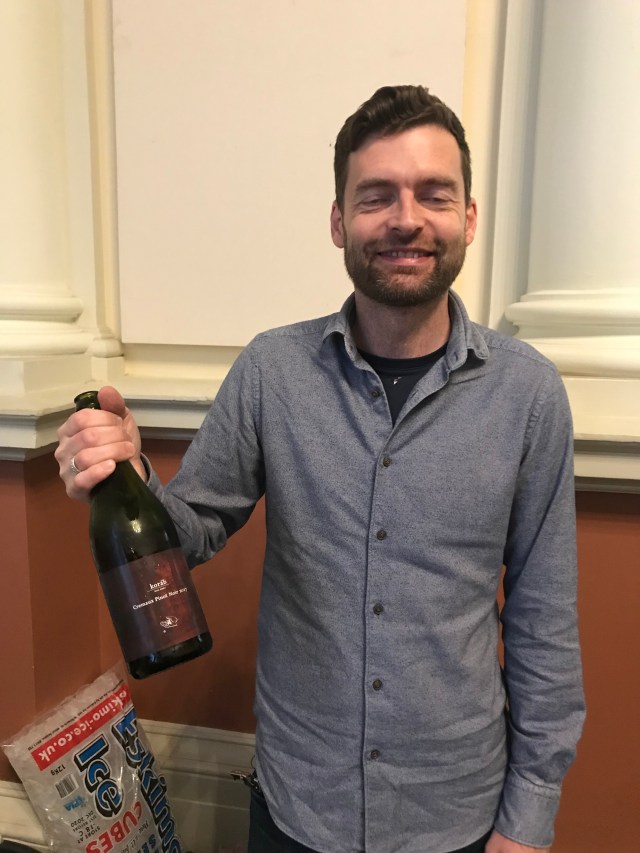
Jiri
Ota Ševcik makes brilliant Frankovka, which is the Moravian name for the better known Austrian variety, Blaufränkisch. I’ve tried that before, and also his excellent Pinoty, but I very much wanted to try out his Neuburger. This is a 2015 wine made from a variety which is not considered very wonderful by more conservative Austrians (and doubtless Czechs as well), it’s a cross of Roter Veltliner and Sylvaner. Often criticised for being too full bodied, carefully nurtured it is capable of producing quite elegant dry whites. This version is soft, juicy and rounded with nice peppery notes. It does come in at 13.5%, though it’s far from ponderous.
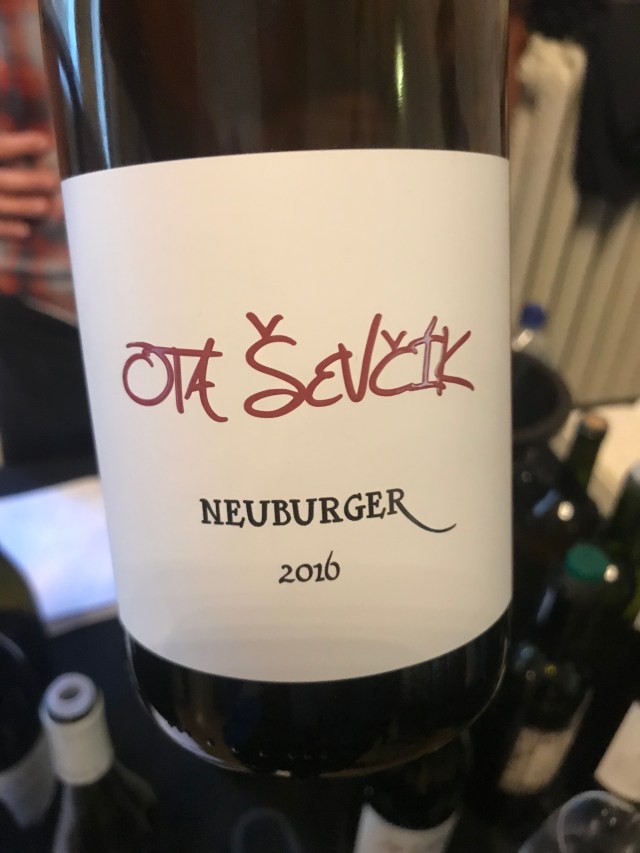
Richard Stávek is, since the mid-1990s, one of the first pioneers of natural wines in Moravia. His winemaking philosophy came from his whole attitude to mixed farming, pursuing a holistic approach to the wellbeing of his land and his animals. I think his field blend skin contact Špigle-Bočky is one of my favourite half-dozen Baskett Press wines, so here I will tell you about a new discovery for me, Divý Ryšak 2016. It is also a field blend which includes Grüner Veltliner and also the hybrid Isabella (cf a Proibida from the Azores Wine Company). There’s also some Blaufränkisch, St-Laurent and Blauer Portugieser in the mix.
This is beautiful. I’d call it a cross between a light red and an orange wine, initially showing a lovely lifted strawberry bouquet, with deeper mandarin, orange peel and spicy citrus on the palate. Spice kicks in on the finish. Mind blown! Want!
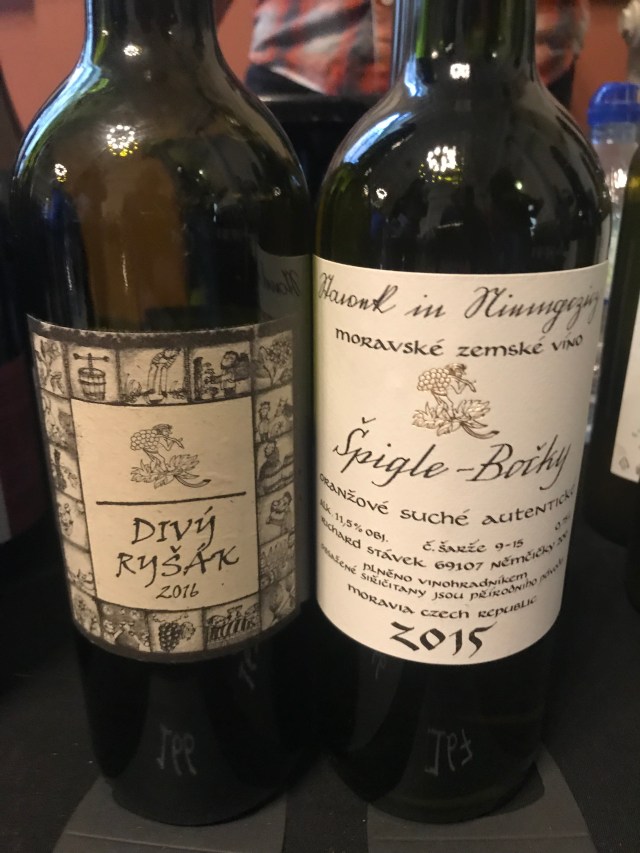
Jaroslav Osička is another of the founding lights of Moravian natural wine, a former wine professor turned producer. In his case he looks the part with his grey hair and trimmed moustache. He makes another of my favourites, Modry Portugal (the Czech name for the Blauer Portugieser variety), but here I’m picking out Tramin Ceverny 2015, made from Gewurztraminer. The variety is pretty obvious from the nose, so it’s floral with exotic fruits. An attractive wine, pure gold colour reflecting greenish glints, quite autumnal.
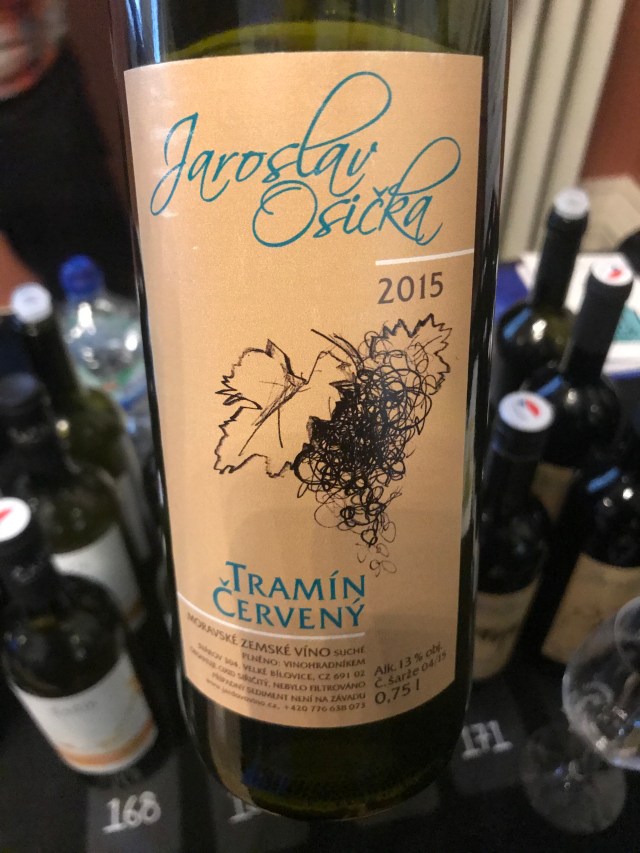
Petr Koráb “Cremant” 2017 is actually a petillant naturel made from 100% Pinot Noir. I’d describe this as a winter sparkler, orange in colour tinged with red. It’s incredibly fresh, but with a warming bitterness. Unusual, yet very appealing.
I tried two wines I’d not remembered seeing before from Krásná Hora, based right near the Slovakian border close to Dolno Poddvorov. These five hectares were originally planted eight hundred years ago by Cistercian monks. Eschewing all synthetic products from the beginning, they are well on the way to being fully biodynamic now.
The specialities here are Pinot Noir, Chardonnay, Riesling, Pinot Blanc, Sauvignon Blanc and Merlot. Sekt Brut Natur Blanc de Pinot Noir 2016 is a delicious Sekt (I think Jiri also has some 2014 which I recall shows nice complexity on top of the freshness here). I was slightly reluctant to try Chardonnay 2016 at first. You see, it is supposedly the favourite wine of John Cleese who, having tried it in a restaurant, came back and bought it in large quantity. Despite its celeb endorsement, I was won over.
The wine is actually a blend, with (in this vintage) just 57% Chardonnay, along with 43% Pinot Blanc. Partially fermented in stainless steel, partially in open old oak vats, it is also aged in a steel and oak combination. There is smooth fruit with a slight plumpness (13% abv) and a fresh finish, very attractive and a wine with its own personality. Which obviously can also be said of John Cleese.
Petr Kočarík Hibernal 2015 is made from a Riesling x Seibel cross (Hibernal). After a year on lees in barrel it still has a very pretty nose, and it reminds me of the bouquet of some English white wines, with just a hint of grassy Sauvignon Blanc style, and an even fainter hint of grapefruit. The palate is very gooseberry, and it has a bit of melon and apple in there, plus some body too (13.5%).
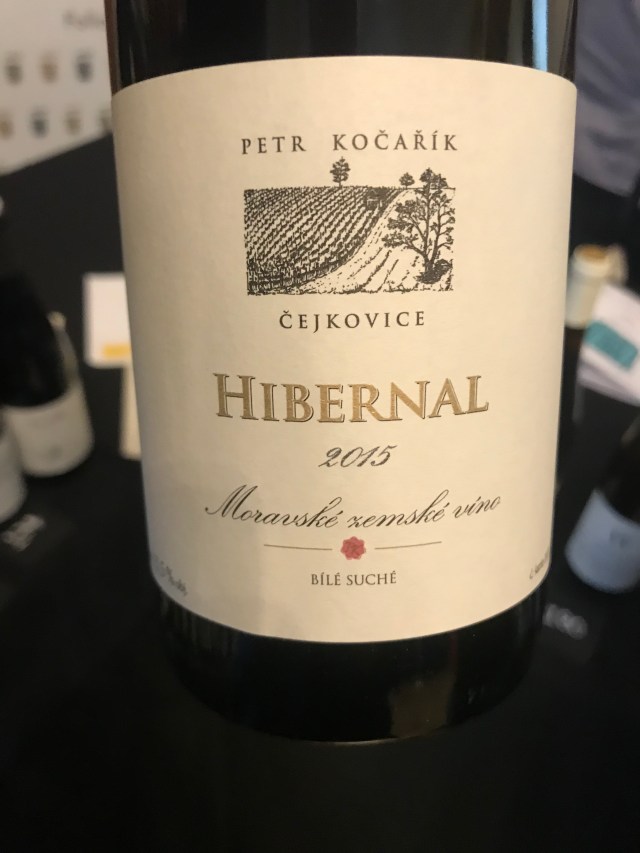
Jakub Novák is another name to look out for, as much as Joiseph, the Austrian producer at Modal Wines. One wine only was on show last week, I’m sure because Jakub’s production is equally tiny, and his wines hit the UK only intermittently. Muller Thurgau 2016 gets a day on skins and then is aged in 500 litre acacia barrels for eight months, on lees with occasional stirring. Fruity but intense is how I’d describe it, but one of the best Muller-Thurgau wines I’ve tried (and there are, as some of you will have discovered, a few very good ones these days).

Magula Family Winery is not Czech, but Slovakian, based in Malokarpatská, or the Lower Carpathians to you and me. Frankovka Modrá 2014 (not 2015 as listed) is, as we have already learnt, Blaufränkisch. They make several cuvées with this variety, but this one is light-to-medium-bodied, quite pale and bright. The fruit is elevated on the nose, and it shows intensity on the palate, but not massive weight. There’s a nice bit of grip to ground it and give a little structure. Tasty stuff, basically.
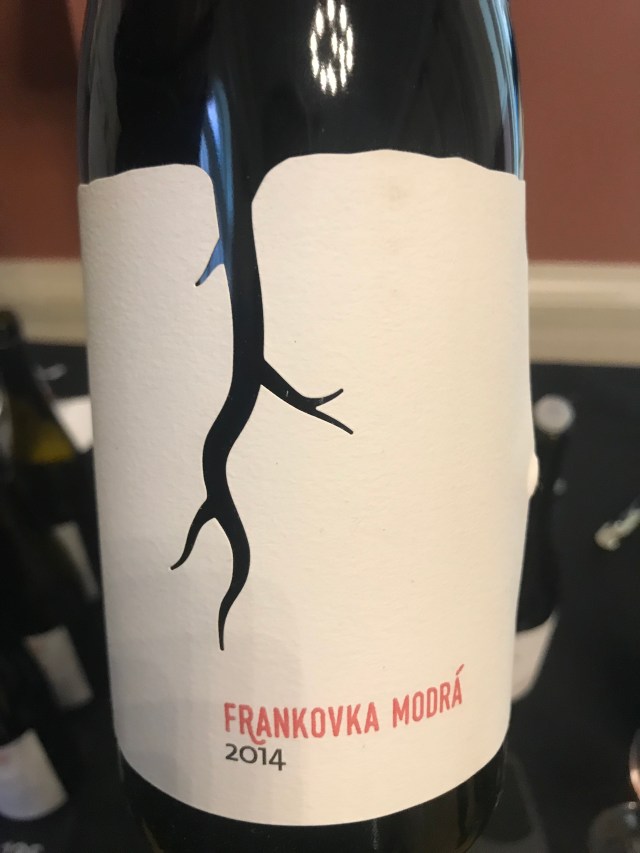
RED SQUIRREL WINE
You’ve had the Red Squirrel Portfolio tasting to digest recently (early September, see here if you missed it) but don’t worry. The RS folks have such a varied portfolio, of which I’ve extolled the virtues quite enough, that I can happily fill in on some wines here that have missed out on recent occasions.
The main producer I want to cover is South Africa’s De Kleine Wijn Koöp. The cooperative is based in Stellenbosch, but sources grapes from all over the country. This producer has always gone a little under my radar, though I’ve tried their wines before. What has grabbed my attention is that they are producing a couple of wines for their UK importer under the Eekhoring label…eekhoring means squirrel in Afrikaans.
Eekhoring Wit 2017 is a Swartland blend based on Chenin Blanc with other varieties (including Grenache Blanc, Marsanne and Viura). It is deliciously simple, crisp and quite floral, but with a beeswax texture as well. Eekhoring Rooi 2018 (yes, 2018) throws together Cinsaut, Syrah and Pinotage. It was only bottled in august, and it is also lively and fruity with a bit of texture on the finish. Both wines are great fun, and they have a well designed label, which really should make this fly off any restaurant wine list.

There’s a bit more seriousness to Kreatur “Die Synachin” 2017. More body, more weight, and more on the nose than the previous wine (flowery, with tea leaf aromas). It has pretty smooth dark fruit yet it’s grippy as well. The label depicts a fictitious composite creature which changes every vintage. Just 3,000 bottles made.
Ou Treffer 2017 is pure Cinsaut, a variety which has only come to the fore in terms of quality wine in recent years, formerly being consigned to the heap of “workhorse varieties”. The very best South African Cinsau[l]t is every bit as good as the much more trumpeted Cabernet Sauvignon, or Syrah, as the Sadie Family’s Pofadder attests. Open top fermenters and old oak is the regime here for a wine that is smooth, rounded, and like so much of the “new” South African Cinsaut, bears a passing resemblance to Pinot Noir for some reason. Just over 600 bottles of this were made, but the UK was lucky enough to receive 200 bottles. Snap ’em up.
Lke Ou Treffer, Knapskêrel 2015 is a Stellenbosch wine, from the Polkadraai Hills to the west of the town. The wine is made, in this case, from Cabernet Franc and it’s a biodynamic wine, just 700 or so bottles with 200 in the UK (thankfully a little more abundant 1,200 bottles were made in 2016). The grapes are farmed by Johan Reyneke and Rosa Kruger, and see whole berry fermentation before ageing in 225-litre, third fill, oak for 18 months. This is like a very ripe Loire red, with a lovely lavender and violet bouquet framing raspberry and a little blackcurrant fruit. 13% alcohol, a juicy steak wine in my book.
The last KWK wine was the pure Cabernet Sauvignon Heimwee 2015 from Stellenbosch. It comes from the same block as the Cabernet Franc and is made in a similar style, quite intense but that fruit intensity is not drowned by oak.
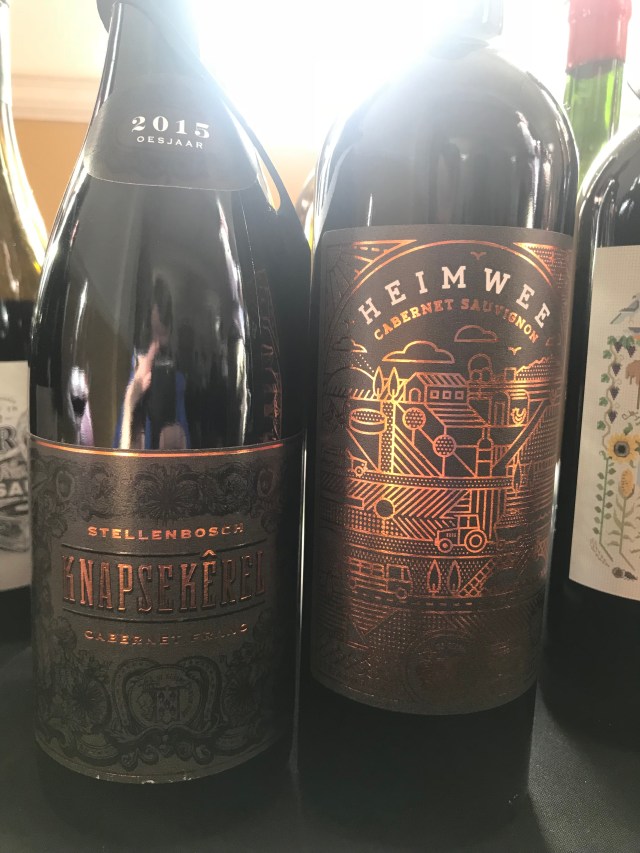
I was taken through the wines by Faan Rabie, a videographer and one of the co-op’s partners, whose detailed explanations were much appreciated. The wines are really good, and I’m not sure why I’d not really focused on them so much before.
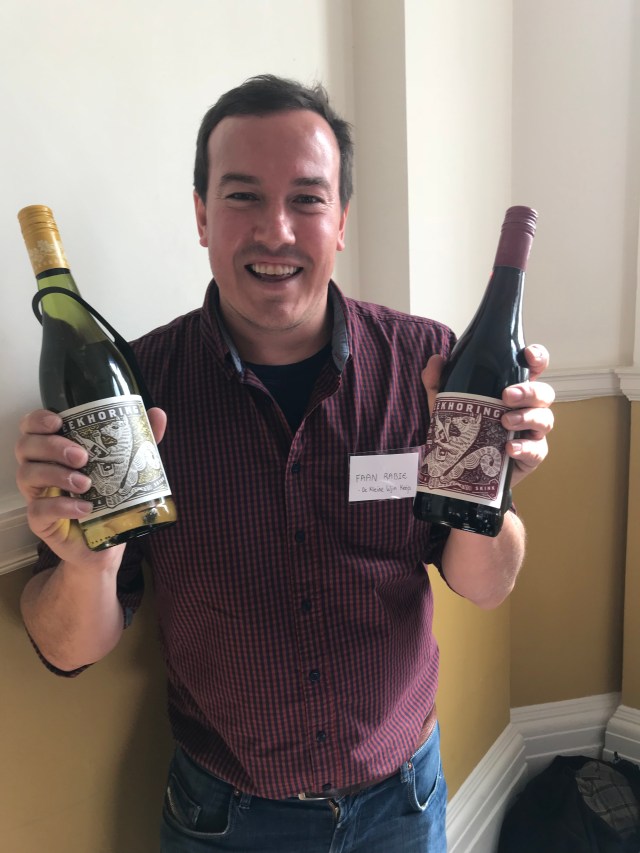
Faan Rabie with the Squirrel cuvées
Before finishing I must give a shout out for a few more producers I’ve missed out in previous pieces on Red Squirrel, and which I tasted last Tuesday. Château de Bel I have mentioned before, and have secretly been drinking their wines. But the one I’ve only had once before, as far as I recall, is Bel en Blanc. Like the red Cabernet Franc, this is a Non-vintage wine, a blend of vintages. It is also unusual in that the variety is Muscadelle, usually a real bit player in Bordeaux.
The nose is quite exotic. I get greengage, a touch of mown grass, and some tropical fruits. The palate combines those tropical fruits with a touch of nuttiness. Truly one of the most fascinating Bordeaux producers around, well out of the ordinary for the region. The Cazenave family farm at Arveyres, southwest of Libourne, but they also have vines in wider Saint-Emilion, plus a third of a hectare in Pomerol. One to explore if you haven’t already.
I spotted Tenuta di Angoris Schioppettino 2016 because I like the grape but rarely get to try one. This was very fruity with fresh acidity, plus a bit of brambly grip. Not a complex wine, but a nice red for autumn, and deceptively alcoholic (13.5%).
I have one or two Valdonica wines in my stash at home. This Tuscan producer has scored a spectacular coup by enticing Tim Manning, Sean O’Callaghan’s right hand man at Riecine when he was there, as head winemaker. I’ve bought several of Tim’s brilliant Vinochisti wines from Winemakers Club and they really are some of the most exciting wines in Tuscany. At Valdonica, Tim is ploughing a similar furrow.
Mersino 2015 is a beautiful Vermentino, for sure, but I slightly preferred Arnaio 2015 this time, which is a Sangiovese/Ciliegiola blend. It has an orange/brick tinge to the colour and a savoury nose. Juicily plump fruit has great acidity, making for a wine which is fresh and long. I have a bottle of this from the 2013 vintage which I shall open soon.
The last producer for this article is from a country that is all too unfashionable, but Red Squirrel has (if you count Azores Wine Company) managed to snag four really good new ones. Morgado do Quintão is in the Algarve, let’s face it, not Portugal’s most famous wine region. But not for Filipe Vasconcellos the school of bung ’em in rotting old oak for a decade and let them dry out good and proper. That’s not to say he’s a modernist. Actually, he wants to revive traditional varieties, and these are what he has planted alongside the vines his grandparents farmed sixty years ago.
The white 2017 here is made from the Crato Branco variety, and is a simple wine in some ways, yet that fantastic salinity gets to you as you sip on it. It’s oyster fresh. The 2017 red is a “clarette” style (paler red), made from Tinta Negra Mole. Be honest, who doesn’t want to try a Tinta Negra Mole these days, especially those of us who were assured by the Madeira buffs that the variety was a disgusting weed. Here, it makes a light wine which mixes red and darker fruits into something just a tiny bit exotic, finishing with crunchy acidity to refresh the palate. They say a rosé is coming soon.

Out The Box really delivered, as I expected it would. It’s one of the best tastings of the year now, and the organisation is pretty good too. Make it a date for the diary in 2019.



















What kind of prices are being asked for the Albino Rocca Wines?
LikeLike
Hi Mark,
For the Ch 14.5, the Barb is 28.5 and the Ronchi is “n/a” (presumably price on application?).
That’s DPD ex vat.
LikeLike